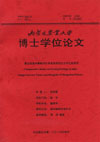| |
不同放牧方式对蒙古高原针茅草原植被特性的影响
中国草原发展论坛一等奖(2009-10-14,安徽)
包秀霞1,易津1,吉格吉德苏仁2,吉木色3
,刘书润4,乌仁其木格1,萨娜斯琴1,
布德巴特5,敖特根托亚5,高娃3,乌兰图雅3,苏布达1
1
内蒙古农业大学
;
2蒙古国家畜牧科学院;3内蒙古草原勘察设计院;
4内蒙古师范大学;5蒙古国“绿金子”项目成员
摘
要:本论文以中蒙两国草原不同管理模式为切入点,于2007-2008年中蒙两国科学家进行联合考察,采用草原生产性能评价和生态学评价方法,分别比较了蒙古高原东南部中蒙比邻地区8个嘎查的不同放牧方式对草原植被特征和草原退化、荒漠化程度的影响。结果表明;内蒙古两季轮牧的群落高度系数、盖度系数、面积系数、重要值系数1、重要值系数3为最高,其次为蒙古四季游牧放牧方式,内蒙古两季轮牧方式的生产性能各指标较高的可能原因与08年内蒙古东乌旗白音布日德嘎查草地类型有关,该嘎查虽然采用两季轮牧方式,但该地区由于人均草场面积比较大,土壤较湿润,草原植被保护的较好,草地生产力较高,从而提高了两季轮牧方式下植被各项指标。但不能认为内蒙古两季轮牧草场质量比蒙古四季游牧好;在生产性能评价角度上,这两种放牧方式下草原退化程度(均轻度退化)基本一致。蒙古四季游牧与内蒙古定居放牧方式间群落各指标有明显的差异。从植物群落生物多样性和功能群结构上能反映出蒙古四季游牧、内蒙古两季轮牧方式下,植物生物多样性较丰富,多年生植物比例较高;而内蒙古定居放牧植物旱生化程度较高。内蒙古两季轮牧方式植被生产性能较高的原因可能与该地区草地类型和生产性能评价法有关。鉴于内蒙古地区人口和牲畜数量远远高于蒙古,多采用定居放牧,植物生物多样性损伤较大,主要表现在禾本科和菊科植物数量明显减少,一年生植物显著增加;定居放牧下还出现植物旱生化程度较高,中旱生和中生植物比例减少的现象;植被盖度减少,植物退化较严重。生产性能评价结果表明中蒙不同放牧方式间草地生产性能差异显著。重要值系数排序结果显示蒙古四季游牧和内蒙古两季轮牧方式样地生产性能较高,草场均属于轻度退化;内蒙古定居方式草场出现重度退化。草原植被生态学评价法是以草原原生植物群落在草原植被总盖度中比例来衡量草原健康程度,结果显示蒙古四季游牧草原出现轻度退化;内蒙古四季轮牧和两季轮牧方式下草场中度退化;而内蒙古定居方式下草原存在极度退化现象。
内蒙古长期定居放牧,定居点周围践踏频率过高,植被没有恢复生长的时期,对植物造成严重的生态损伤,定居时间越长,定居点四周荒漠化程度越严重。四季游牧和两季轮牧都能够缓解放牧压力,保证植物恢复生长。因此认为内蒙古牧区长期定居放牧方式是造成植被退化,草原荒漠化的重要原因之一。
关键词:蒙古高原,针茅草原,放牧方式,植被特性
——————————
资助项目:中蒙国际合作项目资助
作者简介:包秀霞(1982-)女,内蒙古通辽人,博士研究生,主要从事牧草生理生态研究
通讯作者:易 津(1951-)女,四川成都人,教授,博士生导师
, 主要从事牧草生理生态研究
Effects of Vegetation
Characteristics under the Different Grazing in
stipa Grassland of Mongolian Plateau
Baoxiuxia1,Yijin1, Liushurun4,
Jimuse3, Jigjidsuren2,Budebater5,Aotegentuya5,Wurenqimuge1,
Sanasiqin1,Gaowa3, Wulatuya3,
Subuda1
1. Inner Mongolia
Agriculture University, Huhhot;2.Institute of Animal Husbandry in
Mongolia, Ulaanbaatar;3. Institute of Grassland Survey and Design in
Inner Mongolia,Huhhot;4 Inner Mongolia Normal University,
Huhhot;5.Members of ”Green gold project” in Mongolia, Ulaanbaatar
Abstract:
China and Mongolia scientist associatively investigated vegetation
characteristics under the different grazing 2007-2008.We adopted
evaluation of productivity and ecology, mainly compare vegetation
characteristics, grassland degeneration and desertification degree under
different grazing in Mongolian plateau. The result showed that community
height, coverage ,area ,important value coefficient 1, important value
coefficient 2 of two season rotational grazing are the highest, next to
four season nomadic grazing in Mongolia. Productivity in two season
rotational grazing is higher, it related to two season rotational
grazing of 08-NMG-A-4. Grassland area of Baiyinburide village in eastern
Wuzhumuqin banner is bigger, soil is moist, productivity is higher,
protection of grassland vegetation is better. It increased vegetation
index, but we can not consider grassland quality of two seasons
rotational grazing is better than four seasons nomadic grazing. In the
productivity evaluation, grassland degeneration degree between two
seasons rotational and four seasons nomadic grazing is basically same.
Community characteristics are significant differences between four
seasons nomadic grazing and settled grazing. Result of community
biodiversity and functional group showed that biodiversity, perennial
ratio under four seasons nomadic and two seasons rotational grazing is
higher than other grazing. Xerophilization degree under settled grazing
is higher than other grazing. Productivity under two seasons rotational
grazing is higher, it related to grassland type and productivity
evaluation. Inner Mongolia livestock quantity is higher, mainly adopted
settled grazing and lead to plant biodiversity is serious damaged, main
family plants is decreased, annual is significant increased,
Xerophilization degree is enhanced, vegetation coverage is reduced,
vegetation degeneration is serious. Result of productivity evaluation
showed that productivity under different grazing is significant
difference. Grassland is light degradation under four seasons nomadic
and two seasons rotational grazing, grassland is severe degradation
under settled grazing. Ecology evaluation is measured by percent of
total coverage that native plant coverage. Grassland is light
degeneration under four seasons nomadic grazing, grassland is moderately
degeneration under four and two seasons rotational grazing, grassland is
extreme degeneration under settled grazing. Trample frequency is higher
around the settlements in Inner Mongolia, it caused seriously damage of
ecology and grassland desertification. It relieved pressure and
vegetation restoration under four seasons nomadic, two seasons
rotational grazing. Because Inner Mongolia adopted long term’s settled
grazing and lead to vegetation degeneration, grassland desertification.
Keywords:Mongolian
plateau; Stipa grassland; Grazing; Vegetation characteristics
——————————
*
foundation item:International
cooperative project between China and Mongolia(2007-2009)
** Author introduction:Baoxiuxia(1982-)female,doctor
student.
*** Corresponding author:Yijin(1951-)Female,professor,
supervisor of Ph, Email:yijin@163.com |
 |
![]()